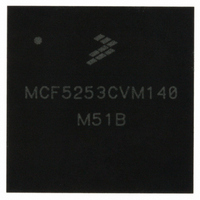MCF5253CVM140 Freescale Semiconductor, MCF5253CVM140 Datasheet - Page 527

MCF5253CVM140
Manufacturer Part Number
MCF5253CVM140
Description
IC MPU 32BIT 140MHZ 225-MAPBGA
Manufacturer
Freescale Semiconductor
Series
MCF525xr
Datasheets
1.MCF5253VM140J.pdf
(34 pages)
2.MCF5253VM140J.pdf
(8 pages)
3.MCF5253VM140J.pdf
(648 pages)
4.MCF5253VM140J.pdf
(2 pages)
Specifications of MCF5253CVM140
Core Processor
Coldfire V2
Core Size
32-Bit
Speed
140MHz
Connectivity
CAN, EBI/EMI, I²C, QSPI, UART/USART, USB OTG
Peripherals
DMA, WDT
Program Memory Type
ROMless
Ram Size
128K x 8
Voltage - Supply (vcc/vdd)
1.08 V ~ 1.32 V
Data Converters
A/D 6x12b
Oscillator Type
External
Operating Temperature
-40°C ~ 85°C
Package / Case
225-MAPBGA
Family Name
MCF5xxx
Device Core
ColdFire V2
Device Core Size
32b
Frequency (max)
140MHz
Instruction Set Architecture
RISC
Supply Voltage 1 (typ)
1.2/3.3V
Operating Supply Voltage (max)
1.32/3.6V
Operating Supply Voltage (min)
1.08/3V
Operating Temp Range
-40C to 85C
Operating Temperature Classification
Industrial
Mounting
Surface Mount
Pin Count
225
Package Type
MA-BGA
Lead Free Status / RoHS Status
Lead free / RoHS Compliant
Number Of I /o
-
Eeprom Size
-
Program Memory Size
-
Lead Free Status / Rohs Status
Compliant
Available stocks
Company
Part Number
Manufacturer
Quantity
Price
Company:
Part Number:
MCF5253CVM140
Manufacturer:
FREESCALE
Quantity:
300
Company:
Part Number:
MCF5253CVM140
Manufacturer:
Freescale Semiconductor
Quantity:
10 000
Part Number:
MCF5253CVM140
Manufacturer:
FREESCALE
Quantity:
20 000
Company:
Part Number:
MCF5253CVM140J
Manufacturer:
Freescale Semiconductor
Quantity:
10 000
- MCF5253VM140J PDF datasheet
- MCF5253VM140J PDF datasheet #2
- MCF5253VM140J PDF datasheet #3
- MCF5253VM140J PDF datasheet #4
- Current page: 527 of 648
- Download datasheet (8Mb)
The DWords 4–11 of a queue head are the transaction overlay area. This area has the same base structure
as a Queue Element Transfer Descriptor. The queue head utilizes the reserved fields of the page pointers
to implement tracking the state of split transactions.
This area is characterized as an overlay because when the queue is advanced to the next queue element,
the source queue element is merged onto this area. This area serves an execution cache for the transfer.
24.8.7
This data structure is to be used only for managing Full- and Low-speed transactions that span a
Host-frame boundary. The software must not use an FSTN in the Asynchronous Schedule. An FSTN in
the Asynchronous schedule results in undefined behavior. The software must not use the FSTN feature
with a host controller whose HCIVERSION register indicates a revision implementation below 0x0096.
Note that FSTNs were not defined for EHCI implementations before Revision 0.96 of the EHCI
Specification and their use may yield undefined results.
Freescale Semiconductor
31
DWord QH Offset
5
6
6
6
6
8
9
9
30 29 28 27 26 25 24 23 22 21 20 19 18 17 16
0x14
0x18
0x18
0x18
0x18
0x20
0x24
0x24
Periodic Frame Span Traversal Node (FSTN)
Table 24-59. Host-Controller Rules for Bits in Overlay (DWords 5, 6, 8 and 9)
11–1
11–5
4–1
7–0
4–0
Bit
31
15
0
0
C-prog-mas
FrameTag
Status[0]
Figure 24-42. Frame Span Traversal Node Structure
NakCnt
S-bytes
Name
Cerr
ioc
dt
k
Normal Path Link Pointer
Back Path Link Pointer
MCF5253 Reference Manual, Rev. 1
Nak counter—RW. This field is a counter the host controller decrements
whenever a transaction for the endpoint associated with this queue head results
in a Nak or Nyet response. This counter is reloaded from RL before a transaction
is executed during the first pass of the reclamation list (relative to an
Asynchronous List Restart condition). It is also loaded from RL during an overlay.
Data toggle. The Data Toggle Control controls whether the host controller
preserves this bit when an overlay operation is performed.
Interrupt on complete. The ioc control bit is always inherited from the source qTD
when the overlay operation is performed.
Error counter. This two-bit field is copied from the qTD during the overlay and
written back during queue advancement.
Ping state (P)/ERR. If the EPS field indicates a high-speed endpoint, then this
field should be preserved during the overlay operation.
Split-transaction complete-split progress. This field is initialized to zero during any
overlay. This field is used to track the progress of an interrupt split-transaction.
The software must ensure that the S-bytes field in a qTD is zero before activating
the qTD. This field is used to keep track of the number of bytes sent or received
during an IN or OUT split transaction.
Split-transaction frame tag. This field is initialized to zero during any overlay. This
field is used to track the progress of an interrupt split-transaction.
15
14 13 12 11 10
Description
9
8
7
6
Universal Serial Bus Interface
5
4
00
00
3
2
Typ
Typ
1
T 0x00
T 0x04
0
Offset
24-65
Related parts for MCF5253CVM140
Image
Part Number
Description
Manufacturer
Datasheet
Request
R
Part Number:
Description:
Mcf5253 Coldfire? Microprocessor Data Sheet
Manufacturer:
Freescale Semiconductor, Inc
Datasheet:
Part Number:
Description:
Manufacturer:
Freescale Semiconductor, Inc
Datasheet:
Part Number:
Description:
Manufacturer:
Freescale Semiconductor, Inc
Datasheet:
Part Number:
Description:
Manufacturer:
Freescale Semiconductor, Inc
Datasheet:
Part Number:
Description:
Manufacturer:
Freescale Semiconductor, Inc
Datasheet:
Part Number:
Description:
Manufacturer:
Freescale Semiconductor, Inc
Datasheet:
Part Number:
Description:
Manufacturer:
Freescale Semiconductor, Inc
Datasheet:
Part Number:
Description:
Manufacturer:
Freescale Semiconductor, Inc
Datasheet:
Part Number:
Description:
Manufacturer:
Freescale Semiconductor, Inc
Datasheet:
Part Number:
Description:
Manufacturer:
Freescale Semiconductor, Inc
Datasheet:
Part Number:
Description:
Manufacturer:
Freescale Semiconductor, Inc
Datasheet:
Part Number:
Description:
Manufacturer:
Freescale Semiconductor, Inc
Datasheet:
Part Number:
Description:
Manufacturer:
Freescale Semiconductor, Inc
Datasheet:
Part Number:
Description:
Manufacturer:
Freescale Semiconductor, Inc
Datasheet:
Part Number:
Description:
Manufacturer:
Freescale Semiconductor, Inc
Datasheet:











